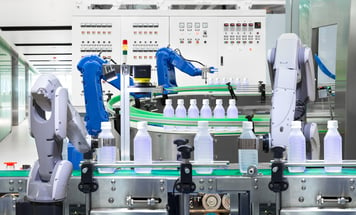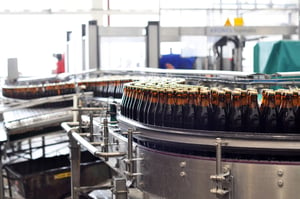 In recent years, the use of collaborative robots (cobots) has offered great efficiencies to the food and beverage industry. These machines reduce the need for humans to perform strenuous, repetitive tasks. Food & Beverage is also using artificial intelligence (AI) to enhance decision-making. The two technologies are being fused to provide an even greater return.
In recent years, the use of collaborative robots (cobots) has offered great efficiencies to the food and beverage industry. These machines reduce the need for humans to perform strenuous, repetitive tasks. Food & Beverage is also using artificial intelligence (AI) to enhance decision-making. The two technologies are being fused to provide an even greater return.
Collaborative Robots in Food & Beverage
Collaborative robots are able to work safely alongside humans without the need for fencing. Most cobots support payloads up to 10kg, which is suitable for a wide range of applications, including pick and place.
Cobots are often programmed by having an operator move the robot to desired fixed points. The cobot memorizes these points and movements, and it repeats the task. They can also be moved to other parts of the production line without disassembly. Since they never forget their preprogrammed tasks, once in place they can go right to work without retraining. Cobots can also be programmed to handle a multitude of SKUs on the line.
Artificial Intelligence in Food & Beverage
Artificial intelligence relies on a continuous process of learning from experience. AI algorithms come up with alternative options to conventional, time-consuming A/B testing. Unlike humans, AI’s ability to adapt to its environment is unlimited, and it has no problem with performing repetitive tasks indefinitely.
- Data Analysis. Machine learning is helping to analyze data quickly. Retailers need to cluster and identify the interests and wants of their main customers. AI can repeatedly analyze this data in real time and inform retailers and suppliers of demand, shortages, and waste.
- Forecasting. Retailers also want to know what products are best to deliver last-minute and which should be kept in stock. AI-powered algorithms analyze what may influence buyer behavior, including promotions, social media, and weather.
- Waste Reduction. Some food processors have turned to AI to calibrate machines to reduce waste on their production lines. These machines identify the optimal use of raw materials based on size and variety.
Collaborative Robots and AI
 Vendors now integrate the capability of cobots to perform repetitive physical tasks and artificial intelligence’s ability to perform repetitive data analytics. This results in better decision-making for the use of cobots.
Vendors now integrate the capability of cobots to perform repetitive physical tasks and artificial intelligence’s ability to perform repetitive data analytics. This results in better decision-making for the use of cobots.
Some applications held out for AI and cobots include:
- Reducing the cobot’s learning curve to complete new tasks by the use of network-connected cobots learning together
- Analyzing and adjusting cobot movements with the use of vision system and sensor data to improve efficiency
- Decreasing downtime by ordering replacement parts and scheduling maintenance ahead of time
This article originally appeared on the Robotics Online Blog.









